Instructions to candidates
- This paper consists of two sections A and B.
- Answer all the questions in the two sections in the spaces provided after each question
- All working must be clearly shown.
- Electronic calculators, mathematical tables may be used.
- All numerical answers should be expressed in the decimal notations.
- You may use ‘g’ as 10m/s2
For Examiner use only
|
SECTION |
QUESTION |
MAX MARKS |
CANDIDATE’S SCORE |
|
A |
1 – 13 |
25 |
|
|
B |
14 |
13 |
|
|
15 |
13 |
|
|
|
16 |
14 |
|
|
|
17 |
07 |
|
|
|
18 |
08 |
|
|
|
|
TOTAL |
80 |
|
QUESTIONS
SECTION A (25 MARKS)
- Figure 1, shows a Vernier caliper of zero error 0.02 cm being used for measuring the diameter of a cylindrical container of height 10 cm. The scale reading of the Vernier is as shown alongside.
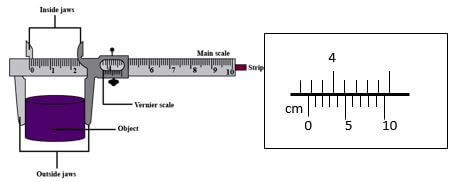
- Determine the diameter of the container (2 marks)
- Estimate the volume of a liquid which can completely fill the container (2 marks)
- State one factor that affects the turning effect of a force on a body. (1 mark)
- Figure 2 shows some air trapped by mercury in a glass tube. The tube is inverted in a dish containing mercury.
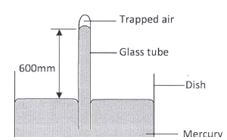
Given that the atmospheric pressure is 760 mmHg and the height of mercury column in the tube is 600 mm, determine the pressure of the air trapped in the tube in mmHg. (2 marks) - Figure 3 shows drops of mercury and water on a glass surface, Explain the difference in the shapes of the drops. (2marks)

Figure 3 - A ball is thrown from the top of a cliff 20m high with a horizontal velocity of 10ms-1. Calculate the distance from the foot of the cliff to where the ball strikes the ground. (3 marks)
- Explain one advantage of mercury over alcohol as a thermometric liquid. (1mark)
- A body of mass M is allowed to slide down an inclined plane. State two factors that affect its final velocity at the bottom of the inclined plane. (2marks)
- A stopwatch reads 08:10:84 and 09:10: 90 before and after an experiment respectively. Determine the duration of the event in SI units. (2marks)
- Explain the meaning of thermodynamics as a branch of physics. (1 mark)
-
- State the Hooke’s Law. (1mark)
- Figure 4 shows identical spiral springs supporting a load of 90N. Each spring has a spring constant k = 200N/m
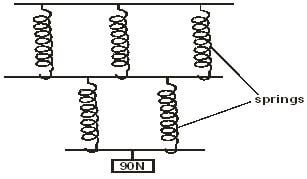
Figure 4
Determine the total extension of the system (take the weight of the cross bars and springs to be negligible) (2 marks)
- Figure 5 shows a rectangular loop with a thin thread loosely tied and dipped into a soap solution.
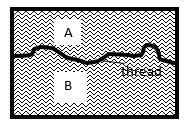
Draw on the space provided what is observed when point A is punctured. (1mark) -
Two horizontal strings are attached to a block, resting on a frictionless surface, as shown in figure 6.

Figure 6
A force of 100N pulls on one string. The block does not move. Find the value of the force, F on the other string. (1 mark) -
A wooden bench feels neither warm nor cold when touched by your bare hands. Explain this observation. (2 marks)
SECTION B (55 MARKS)
-
- Explain why bodies in circular motion undergo acceleration even when their speed is constant. (1mark)
- A particle moving along a circular path of radius 5cm describes an arc of length 2cm every second. Determine:
- Its angular velocity. (1mark)
- Its periodic time. (2marks)
- A stone of mass 150g is tied to the end of a string 80cm long and whirled in a vertical circle at 2rev/s. Determine the maximum tension in the string. (3marks)
- State one factor affecting centripetal force (1mark)
- State the principle of conservation of linear momentum (1 mark)
- A bullet of mass 60g is fired horizontally with a velocity of 200 m/s into a suspended stationary wooden block of mass 2940g. Determine:
- Common velocity of both the bullet and the block, if the bullet embedded into the block. (2 marks)
- Height to which the block rises. (2 marks)
-
- State two factors that affect the boiling point of a liquid (2 marks)
- 100g of a liquid at a temperature of 100 C is poured into a well lagged calorimeter. An electric heater rated 50W is used to heat the liquid. The graph in figure 7 shows the variation of the temperature of the liquid with time.
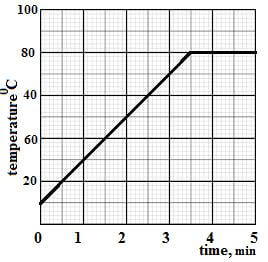
Figure 7- From the graph, determine the boiling point of the liquid (1 mark)
- Determine the heat given out the by the heater between the times t = 0.5 minutes and t = 5.0 minutes (3 marks)
- From the graph determine the temperature change between the times t = 0.5 minutes and t = 5.0 minutes, hence determine the specific heat capacity of the liquid (3 marks)
- 1.8 g of vapor was collected from above the liquid between the times t= 3.5 minutes and t= 4.5 minutes. Determine the specific latent heat of vaporization of the liquid (4 marks)
-
- State the law of floatation (1 mark)
- Figure 8 below shows a simple hydrometer

Figure 8- Identify the parts labelled A and B (2 marks)
- State the purpose of the part labelled B (1 mark)
- How would the hydrometer be made more sensitive? (1 mark)
- Describe how the hydrometer is calibrated to measure relative density (3 marks)
- Figure 9 shows a cork floating on water and held to the bottom of the beaker by a thin thread.
- Name the forces acting on the cork (3 marks)
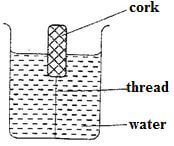
Figure 9 - Describe how each of the forces mentioned in (i) above changes when water is added until the container is completely filled (3 marks)
- Name the forces acting on the cork (3 marks)
-
- Figure 10 shows a graph of pressure against volume for a fixed mass of a gas at constant temperature.
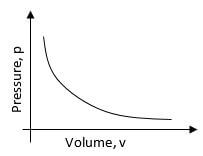
Figure 10
In the space provided, sketch a graph of pressure, p against 1/v (1 mark) - Explain the pressure law using the kinetic theory of matter (3 marks)
- 20cm3 of a gas exerts a pressure of 760mmHg at 25ºC. Determine the temperature of the gas when the pressure increases to 900mmHg and the volume decreases to 15 cm3. (3 marks)
- Figure 10 shows a graph of pressure against volume for a fixed mass of a gas at constant temperature.
-
- Define the term velocity ratio of a machine (1 mark)
- The figure 11, below shows part of the hydraulic lift system. State any one property of the liquid under which the hydraulic system works (1 mark)
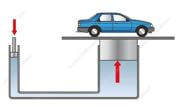
Figure 11 - The hydraulic lift machine above has velocity ratio 45 and it overcomes a load of 4500 N when an effort of 135 N is applied. Determine:
- The mechanical advantage of the machine (2 marks)
- Efficiency of the machine (3 marks)
- The percentage of work that goes to waste (1 mark)
MARKING SCHEME
SECTION A (25 MARKS)
- Figure 1, shows a Vernier caliper of zero error 0.02 cm being used for measuring the diameter of a cylindrical container of height 10 cm. The scale reading of the Vernier is as shown alongside.

- Determine the diameter of the container (2 marks)
reading=3.7+0.02=3.72cm ;
actual diameter=3.72-0.02=3.70cm ; - Estimate the volume of a liquid which can completely fill the container (2 marks)
volume=πr2 h
3.142×(3.70)/2×(3.70)/2×10 ;=107.5cm3 ; correct substitution and correct answer with units
- Determine the diameter of the container (2 marks)
- State one factor that affects the turning effect of a force on a body. (1 mark)
• Magnitude of the force
• Perpendicular distance between pivot and line of action of force
1-mark max. (mark only the first response of the learner) - Figure 2 shows some air trapped by mercury in a glass tube. The tube is inverted in a dish containing mercury.

Given that the atmospheric pressure is 760 mmHg and the height of mercury column in the tube is 600 mm, determine the pressure of the air trapped in the tube in mmHg. (2 marks)
atm.pressure=liquid pressure+air pressure formula/sub
760=600+air pressure ;
Therefore, air pressure = 760-600=160mmHg ; correct answer with units - Figure 3 shows drops of mercury and water on a glass surface, Explain the difference in the shapes of the drops. (2marks)

Figure 3
Cohesive force among mercury molecules is stronger than adhesive force between mercury and glass molecules; in water, adhesive force between water and glass molecules is stronger than cohesive force between water molecules; - A ball is thrown from the top of a cliff 20m high with a horizontal velocity of 10ms-1. Calculate the distance from the foot of the cliff to where the ball strikes the ground. (3 marks)
h=1/2 gt2≡20=1/2×10×t2→t=2 seconds ; award for time
R=ut→R=10×2;=20m; formula/sub and the correct answer with units - Explain one advantage of mercury over alcohol as a thermometric liquid. (1mark)
Higher boiling point so it can measure higher temperature than alcohol; - A body of mass M is allowed to slide down an inclined plane. State two factors that affect its final velocity at the bottom of the inclined plane. (2marks)
• Angle of inclination of the plane
• Vertical Height of the inclined plane
• Length of the plane
• Frictional force between the plane and the body
Maximum of two marks but consider only the first two responses of the learner - A stopwatch reads 08:10:84 and 09:10: 90 before and after an experiment respectively. Determine the duration of the event in SI units. (2marks)
final time=(9×60)+10.90=550.90s award for either final/initial time
Initial time = (8×60)+10.84=490.84s ;
Time taken = 60.06 seconds ; correct answer with units - Explain the meaning of thermodynamics as a branch of physics. (1 mark)
The study of heat and its transformation to and from other forms of energy; -
- State the Hooke’s Law. (1mark)
For an elastic material, extension is directly proportional to the stretching force provided elastic limit is not exceeded; - Figure 4 shows identical spiral springs supporting a load of 90N. Each spring has a spring constant k = 200N/m

Figure 4
Determine the total extension of the system (take the weight of the cross bars and springs to be negligible) (2 marks)
K1=3×200=600Nm-1; so extension is: F/K=90/600=0.15m
K2=2×200=400Nm-1-so extension is: F/K=90/400=0.225m
award for either combined spring constant
total extension=0.15+0.225=0.375m ; correct answer with units
- State the Hooke’s Law. (1mark)
- Figure 5 shows a rectangular loop with a thin thread loosely tied and dipped into a soap solution.

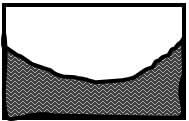
Draw on the space provided what is observed when point A is punctured. (1mark) -
Two horizontal strings are attached to a block, resting on a frictionless surface, as shown in figure 6.

Figure 6
A force of 100N pulls on one string. The block does not move. Find the value of the force, F on the other string. (1 mark)
0=100N+(-F) therefore, F= 100N; -
A wooden bench feels neither warm nor cold when touched by your bare hands. Explain this observation. (2 marks)
Wood is a poor conductor of heat; it does not therefore take away heat from the hand hence no change in body temperature;
SECTION B (55 MARKS)
-
- Explain why bodies in circular motion undergo acceleration even when their speed is constant. (1mark)
The change in the direction of velocity constitute the acceleration; - A particle moving along a circular path of radius 5cm describes an arc of length 2cm every second. Determine:
- Its angular velocity. (1mark)
θ=s/r=2/5=0.4rad therefore, ω=(0.4)/1=0.4rads-1; - Its periodic time. (2marks)
ω=2π/T=T=2π/(0.4);=15.71 seconds;
- Its angular velocity. (1mark)
- A stone of mass 150g is tied to the end of a string 80cm long and whirled in a vertical circle at 2rev/s. Determine the maximum tension in the string. (3marks)
ω=2πf=2π×2=12.57rads-1 ; award for correct angular velocity
Fc=mrω2=0.15×0.8×12.572=18.96N ; correct value of force
Maximum tension = weight+Fc=1.5+18.96=20.46N ; correct answer in newton - State one factor affecting centripetal force (1mark)
• Mass of the object in circular motion
• Radius of the circular path
• Velocity of the object
(mark only the first response of the learner) - State the principle of conservation of linear momentum (1 mark)
For a system of colliding bodies, the total linear momentum before and after the collision remains a constant; - A bullet of mass 60g is fired horizontally with a velocity of 200 m/s into a suspended stationary wooden block of mass 2940g. Determine:
- Common velocity of both the bullet and the block, if the bullet embedded into the block. (2 marks)
momentum before collission=momentum after collission
(0.06×200)+(2.94×0)=3V; formula or substitution
12=3V therefore, V = 12/3=4m/s ; correct answer with units - Height to which the block rises. (2 marks)
mgh=1/2 mv2; →h=(0.5×42)/10=0.8m; formula/sub; correct answer with units;
- Common velocity of both the bullet and the block, if the bullet embedded into the block. (2 marks)
- Explain why bodies in circular motion undergo acceleration even when their speed is constant. (1mark)
-
- State two factors that affect the boiling point of a liquid (2 marks)
• Impurities;
• Pressure; - 100g of a liquid at a temperature of 100 C is poured into a well lagged calorimeter. An electric heater rated 50W is used to heat the liquid. The graph in figure 7 shows the variation of the temperature of the liquid with time.

Figure 7- From the graph, determine the boiling point of the liquid (1 mark)
80ºC ; - Determine the heat given out the by the heater between the times t = 0.5 minutes and t = 5.0 minutes (3 marks)
time=(5-1.5)×60=210seconds ;
heat(energy)=power×time=50×210;=10500J ;
- From the graph, determine the boiling point of the liquid (1 mark)
- From the graph determine the temperature change between the times t = 0.5 minutes and t = 5.0 minutes, hence determine the specific heat capacity of the liquid (3 marks)
Change in temperature = 80-20=60ºC ;
Heat energy absorbed = mc∆θ →10500=0.1×c×60 ;formula or substitution
c=10500/(0.1×60)=1750J/kg K ; correct answer with units - 1.8 g of vapor was collected from above the liquid between the times t= 3.5 minutes and t= 4.5 minutes. Determine the specific latent heat of vaporization of the liquid (4 marks)
Heat energy supplied by the heater = heat energy spent to vaporize the liquid ;
mLv=50×1×60 ; ; correct substitutions for both energy supplied and absorbed
Lv=3000/(0.1)=30,000J/kg ; correct answer with correct units
- State two factors that affect the boiling point of a liquid (2 marks)
-
- State the law of floatation (1 mark)
A floating body displaces its own weight of fluid in which it floats; - Figure 8 below shows a simple hydrometer

Figure 8- Identify the parts labelled A and B (2 marks)
A bulb ;
B lead-shots ; - State the purpose of the part labelled B (1 mark)
It enables the hydrometer float upright ;
- Identify the parts labelled A and B (2 marks)
- How would the hydrometer be made more sensitive? (1 mark)
Using a narrower glass-stem ; - Describe how the hydrometer is calibrated to measure relative density (3 marks)
Float the hydrometer in a liquid of known relative density and mark level of the liquid on the stem;
Float the hydrometer again in another liquid of known relative density and mark its level on the stem;
Divide the length between the marks into equal divisions and label it accordingly ; - Figure 9 shows a cork floating on water and held to the bottom of the beaker by a thin thread.
- Name the forces acting on the cork (3 marks)

Figure 9
• Tension ;
• Up-thrust ;
• Weight - Describe how each of the forces mentioned in (i) above changes when water is added until the container is completely filled (3 marks)
• Tension increases ;
• Up-thrust increases ;
• weight remains constant ;
- Name the forces acting on the cork (3 marks)
- State the law of floatation (1 mark)
-
- Figure 10 shows a graph of pressure against volume for a fixed mass of a gas at constant temperature.

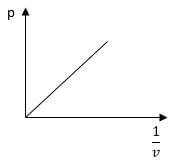
Figure 10
In the space provided, sketch a graph of pressure, p against 1/v (1 mark) - Explain the pressure law using the kinetic theory of matter (3 marks)
When a gas is heated, its molecules gain kinetic energy and move about faster; since volume is constant, the molecules will bombard the wall of the container with greater momenta. The total rate of change of momentum (force) will therefore increase; the resulting force per unit area (pressure) will therefore increase; - 20cm3 of a gas exerts a pressure of 760mmHg at 25ºC. Determine the temperature of the gas when the pressure increases to 900mmHg and the volume decreases to 15 cm3. (3 marks)
(p1 v1)/T_1 =(P2 v2)/T2 ; formula
(760×20)/298=(900×15)/T ;≡T= 264.7k; Correct substitution and answer with units
- Figure 10 shows a graph of pressure against volume for a fixed mass of a gas at constant temperature.
-
- Define the term velocity ratio of a machine (1 mark)
The ratio of effort distance to load distance; - The figure 11, below shows part of the hydraulic lift system. State any one property of the liquid under which the hydraulic system works (1 mark)

Figure 11
• Incompressible
• High boiling point and low freezing point
• Non-corrosive
Award one mark for any correct response - The hydraulic lift machine above has velocity ratio 45 and it overcomes a load of 4500 N when an effort of 135 N is applied. Determine:
- The mechanical advantage of the machine (2 marks)
M.A=LOAD/EFFORT=4500/135;=33.33; correct substitution and correct answer - Efficiency of the machine (3 marks)
∩=(M.A)/(V.R)×100 ; formula
≡∩=(33.33)/45×100 ; substitution
→∩=74.07% ; correct evaluation in % - The percentage of work that goes to waste (1 mark)
100-74.07=25.93% ;
- The mechanical advantage of the machine (2 marks)
- Define the term velocity ratio of a machine (1 mark)
Download Physics Paper 1 Questions and Answers - KCSE 2022 Mock Exams Set 1.
Tap Here to Download for 50/-
Get on WhatsApp for 50/-
Why download?
- ✔ To read offline at any time.
- ✔ To Print at your convenience
- ✔ Share Easily with Friends / Students
